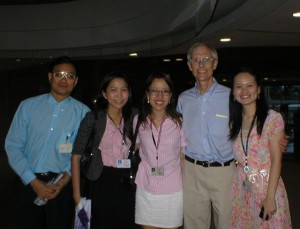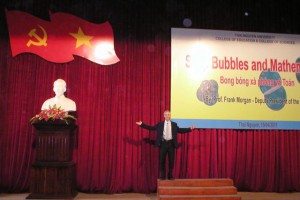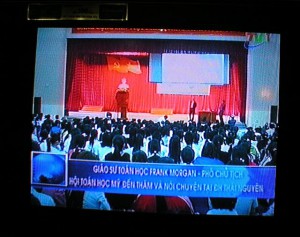28th April 2011, 06:35 am
There seem to be no obstacles to progress in Thailand: everything is for sale. The streets of Bangkok are crowded with vendors of all kinds of food and clothing and services. If you need soap bubbles for your talk, you can find them at Toys R Us. If you need computer repair because you spilled soap bubbles on your new MacBook Air during your talk, there are even some ten authorized Apple repair shops, as in the famous Pantip Plaza, which also boasts three Apple sales shops. If you want to try durian ice cream despite the smell, it’s available at the nearest Metro station. If you want to visit some temples, you can hire a tuk-tuk for an hour for 30 Baht = $1, as long as you’re willing to visit a sponsoring tailor shop on the way.
The first three pictured former students treated me to dinner at In Love restaurant by the river.


Harit Rodpraser, Aom Kitichaiwat, Ta Banchuin, and Rungporn Roengpitya work at the Bank of Thailand. I found them through former student Chung Truong, pictured here at his penthouse room, who just showed up at my talk in Ho Chi Minh City. Continue reading ‘Shopping in Thailand (and ICMA-MU Dec 2011)’ »
20th April 2011, 03:59 am
Mathematics is prospering in Vietnam, supported by the latest technology. Most classrooms have built-in computer projection, and they readily supply document cameras and wireless lavaliere mikes. The internet is reliable and readily available. They’ve even figured out how to block Facebook.


Talk on “Soap Bubbles and Mathematics” to 1000 students in Thai Nguyen covered on TV.
Also see TV coverage of Hue talks.
4th April 2011, 01:16 pm
When friends hear that I’m on a math visit to Pakistan, they often say something about safety. Actually, despite heightened security, I’ve felt completely safe and at home here. The culminating experience was setting up my computer well before talks at QAU, NUST, and GCU* and finding I could leave it unattended, rarely the case in the US or anywhere else.
Incidentally, as of 2008-09, 46% of undergraduates in Pakistan are women, up from 37% in 2001-02. During this period total enrollment has more than doubled. Similarly 31% of PhD students are women, up from 20%.
*See the article by Loring Tu on the GCU “Abdus Salam School of Mathematical Sciences in Pakistan” in the August 2011 Notices of the American Mathematical Society.
4th April 2011, 09:15 am
The most important lemma of regularity for an m-dimensional area-minimizing surface S in Rn is the monotonicity of the mass ratio about a point p of S, i.e., the ratio of the area inside an n-ball about p of radius r to the volume of an m-ball of radius r [FF, Thm. 9.13 and proof], [M, 9.3]. Here in Lahore, Pakistan, at the Abdus Salam School of Mathematical Sciences, Rein Zeinstra told me that such monotonicity generalizes a similar result by Lelong [L] for complex analytic varieties (which are area minimizing). Similarly, the compactness theorem of geometric measure theory generalizes a later such result for complex analytic varieties. See a Math Review by Stoll.
[FF] Herbert Federer and Wendell H. Fleming, Normal and integral currents, Ann. of Math. 72 (1960), 458-520.
[L] Pierre Lelong, Propriétés métriques des variétés analytiques complexes définies par une équation, Ann. Sci. École Norm. Sup. 67 (1950), 393–419.
[M] Frank Morgan, Geometric Measure Theory: a Beginner’s Guide, Academic Press, 4th ed., 2009.
Category:
Math |
Comments Off on Monotoncity from Lelong to Federer-Fleming




 Welcome to my blog. I also have a blog at the
Welcome to my blog. I also have a blog at the